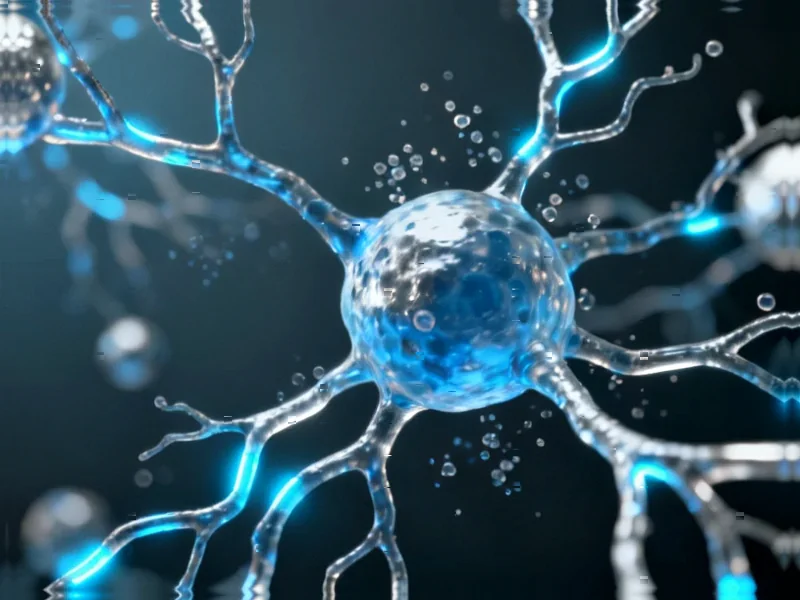Breakthrough Discovery in Neurodevelopmental Disorders
Scientists have identified a new neurodevelopmental syndrome caused by mutations in the UNC13A gene, according to a recent study published in Nature Genetics. The research, involving 48 patients from multiple clinical centers, reveals how different variants in this crucial synaptic protein lead to a spectrum of neurological symptoms through impaired synaptic transmission.
Table of Contents
Sources indicate that the UNC13A gene plays a critical role in neurotransmitter release at synapses, the communication points between neurons. The study demonstrates that pathogenic variants in this gene disrupt normal brain development and function, leading to conditions ranging from severe intellectual disability to movement disorders and treatment-resistant seizures.
Three Distinct Inheritance Patterns Identified
According to the report, researchers classified patients into three main groups based on their genetic variants and inheritance patterns. The first group consisted of six patients with severe to profound neurodevelopmental impairments who carried biallelic variants inherited in an autosomal recessive manner. These patients reportedly presented with global developmental delay, intellectual disability, hypotonia, and various seizure types.
A second group of 13 patients carried heterozygous de novo missense variants affecting a specific protein region researchers termed the “UNC13 hinge.” Analysts suggest this region, spanning amino acids 808-814, forms a mutation hotspot that causes disorders through an autosomal dominant pattern. Patients in this group typically exhibited variable degrees of developmental delay, movement abnormalities including ataxia and tremor, and seizures that were largely refractory to treatment.
The third group involved a multi-generational family carrying a pathogenic heterozygous missense variant (C587F) that caused milder symptoms, allowing for autosomal dominant familial inheritance across at least four affected members spanning two generations., according to technological advances
Mechanistic Insights into Synaptic Dysfunction
The research team conducted extensive experiments to understand how different UNC13A variants disrupt synaptic function. According to their findings, some variants dramatically reduce the amount of UNC13A protein at synapses, while others create gain-of-function mutations that enhance neurotransmitter release.
Laboratory studies using mouse neurons revealed that certain variants, particularly E52K and R202H, caused a severe reduction in synaptic UNC13A levels. The report states that neurons expressing the E52K variant showed complete absence of measurable synaptic transmission, indicating a severe synaptic vesicle priming deficit.
Conversely, variants in the UNC13 hinge region created gain-of-function mutations. Researchers observed that the G808D variant caused more than a twofold increase in spontaneous neurotransmitter release and enhanced evoked transmission. The study suggests these mutations make synaptic vesicles more likely to fuse spontaneously, potentially explaining the seizure susceptibility observed in affected patients.
Impaired Cellular Signaling Mechanisms
The investigation also revealed how the C587F variant disrupts diacylglycerol (DAG) signaling, an important regulatory pathway in neurons. According to experimental data, this mutation blocks UNC13A’s ability to translocate to the plasma membrane in response to DAG signaling, effectively making the protein unresponsive to this key regulatory mechanism.
Researchers demonstrated that while basal synaptic transmission remains largely intact with this variant, the ability to potentiate synaptic strength in response to DAG signaling is completely abolished. This finding potentially explains why patients with this particular mutation exhibit relatively milder symptoms that can be inherited familially.
Conservation Across Species
The study extended its findings to C. elegans models, where researchers introduced equivalent mutations into the unc-13 gene. According to their reports, both homozygous and heterozygous worms carrying G808C and P814L mutations showed significantly faster paralysis when exposed to aldicarb, indicating acetylcholine hypersecretion consistent with the gain-of-function phenotype observed in human patients and mouse neurons.
This conservation across species strengthens the evidence for pathogenicity and suggests the underlying mechanisms are fundamental to synaptic function across evolution.
Clinical Implications and Future Directions
The identification of this new neurodevelopmental syndrome has significant implications for genetic diagnosis and counseling. According to analysts, the research provides clear genotype-phenotype correlations that can help clinicians interpret UNC13A variants and provide accurate prognoses.
Researchers emphasize that their findings demonstrate UNC13A’s crucial role in human brain development and function. The study reportedly opens new avenues for understanding how synaptic dysfunction contributes to neurodevelopmental disorders and may eventually lead to targeted therapeutic approaches.
The report concludes that pathogenic UNC13A variants cause a spectrum of neurodevelopmental deficiencies through distinct mechanisms affecting synaptic vesicle priming, spontaneous release probability, and responsiveness to regulatory signals, highlighting the complex relationship between synaptic function and brain development.
Related Articles You May Find Interesting
- South Africa’s Energy Transition Accelerates with 720 MW Karoo Wind Power Initia
- UK Inflation Holds Steady at 3.8% Amid Easing Food Price Pressures
- UK Inflation Holds Steady as Food Costs Ease, Offering Relief to Households and
- Lynk Global and Omnispace Forge Merger to Bolster Satellite-to-Phone Connectivit
- UK Inflation Holds Steady Amid Easing Food Costs, Gold Volatility Follows Suit
References & Further Reading
This article draws from multiple authoritative sources. For more information, please consult:
- http://en.wikipedia.org/wiki/UNC13A
- http://en.wikipedia.org/wiki/Seizure
- http://en.wikipedia.org/wiki/Zygosity
- http://en.wikipedia.org/wiki/Neurotransmission
- http://en.wikipedia.org/wiki/Hypotonia
This article aggregates information from publicly available sources. All trademarks and copyrights belong to their respective owners.
Note: Featured image is for illustrative purposes only and does not represent any specific product, service, or entity mentioned in this article.



